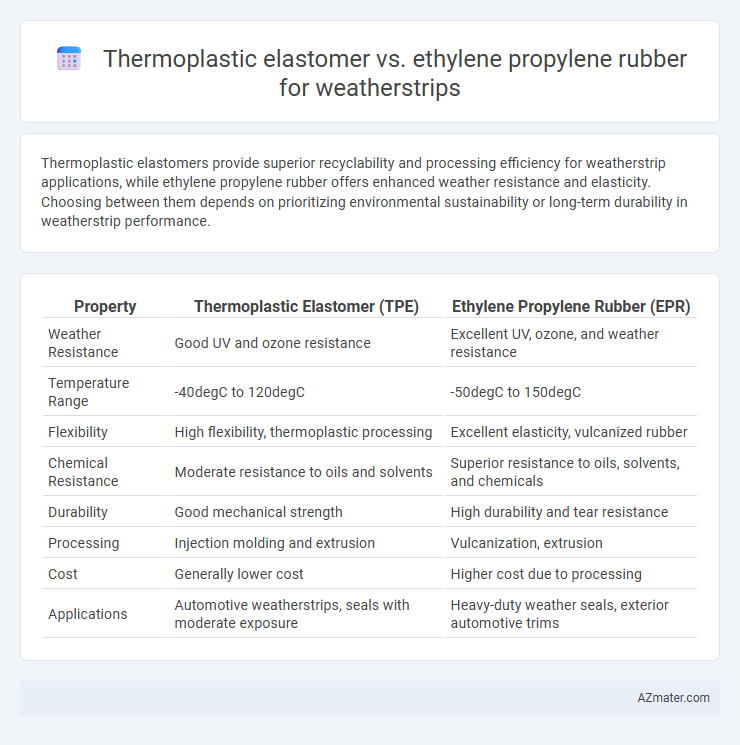Thermoplastic elastomers provide superior recyclability and processing efficiency for weatherstrip applications, while ethylene propylene rubber offers enhanced weather resistance and elasticity. Choosing between them depends on prioritizing environmental sustainability or long-term durability in weatherstrip performance.
Table of Comparison
| Property | Thermoplastic Elastomer (TPE) | Ethylene Propylene Rubber (EPR) |
|---|---|---|
| Weather Resistance | Good UV and ozone resistance | Excellent UV, ozone, and weather resistance |
| Temperature Range | -40degC to 120degC | -50degC to 150degC |
| Flexibility | High flexibility, thermoplastic processing | Excellent elasticity, vulcanized rubber |
| Chemical Resistance | Moderate resistance to oils and solvents | Superior resistance to oils, solvents, and chemicals |
| Durability | Good mechanical strength | High durability and tear resistance |
| Processing | Injection molding and extrusion | Vulcanization, extrusion |
| Cost | Generally lower cost | Higher cost due to processing |
| Applications | Automotive weatherstrips, seals with moderate exposure | Heavy-duty weather seals, exterior automotive trims |
Introduction to Weatherstrips: Importance and Applications
Weatherstrips play a crucial role in sealing gaps around doors and windows, preventing air, water, dust, and noise infiltration, which enhances energy efficiency and comfort. Thermoplastic elastomers offer superior flexibility and ease of manufacturing for weatherstrip profiles, while ethylene propylene rubber provides excellent resistance to ozone, UV rays, and extreme weather conditions. Selecting the appropriate material depends on balancing durability, environmental resistance, and cost-effectiveness for optimal weatherstrip performance.
Overview of Thermoplastic Elastomer (TPE)
Thermoplastic elastomers (TPE) combine the flexibility of rubber with the recyclability and processing ease of plastics, making them ideal for weatherstrip applications requiring durability and adaptability. TPE materials exhibit excellent resistance to UV radiation, ozone, and temperature fluctuations, ensuring long-term performance in automotive and architectural sealing. Their ability to be molded into complex shapes with consistent quality enhances manufacturing efficiency and design versatility compared to traditional ethylene propylene rubber (EPR).
Overview of Ethylene Propylene Rubber (EPR/EPDM)
Ethylene Propylene Rubber (EPDM) is a synthetic elastomer widely used in weatherstrip applications due to its exceptional resistance to UV rays, ozone, and extreme temperatures ranging from -40degC to 150degC. Its superior elasticity and durability make EPDM ideal for sealing gaps in automotive and architectural weatherstripping, preventing air and water infiltration. Compared to thermoplastic elastomers, EPDM offers enhanced weather resistance and long-term performance in outdoor environments.
Material Properties Comparison: TPE vs EPDM
Thermoplastic elastomers (TPE) offer superior flexibility and enhanced recyclability compared to Ethylene Propylene Diene Monomer (EPDM), making TPE ideal for applications requiring ease of processing and environmental sustainability. EPDM excels in chemical resistance, UV stability, and high-temperature performance, which ensures long-lasting durability in harsh weatherstripping environments. The choice between TPE and EPDM hinges on balancing flexibility and recyclability benefits of TPE against the robust weather and heat resistance intrinsic to EPDM.
Weather Resistance and Durability
Thermoplastic elastomers (TPE) exhibit superior weather resistance due to their enhanced UV stability and resistance to oxidation, making them ideal for long-lasting weatherstrips. Ethylene propylene rubber (EPR) offers excellent ozone and heat resistance, but can degrade faster under prolonged UV exposure compared to TPE. Durability in outdoor conditions favors TPE for maintaining flexibility and mechanical properties, while EPR is valued for its elastomeric resilience in extreme temperatures.
Flexibility and Compression Set Performance
Thermoplastic elastomers (TPE) exhibit superior flexibility compared to ethylene propylene rubber (EPR), enabling them to conform to complex shapes and maintain seal integrity under dynamic conditions. EPR demonstrates lower compression set values, indicating enhanced resilience and longer-term performance in retaining original shape after compressive stress. These characteristics make TPE preferable for applications requiring high flexibility, while EPR excels where minimal permanent deformation under constant compression is critical.
Installation and Manufacturing Differences
Thermoplastic elastomers (TPE) offer easier installation due to their flexibility and ability to be molded into complex shapes without requiring curing, enabling faster manufacturing cycles and reduced tooling costs. Ethylene propylene rubber (EPR) requires vulcanization during production, which lengthens manufacturing time and complicates installation because of its stiffer material properties and need for precise fitment. TPE's recyclable nature also enhances sustainability in weatherstrip applications, while EPR provides superior resistance to heat and ozone, influencing material choice based on environmental exposure.
Cost Analysis: Production and Lifecycle
Thermoplastic elastomers (TPE) generally offer lower production costs than ethylene propylene rubber (EPR) due to their ease of processing through injection molding and faster cycle times, which reduces manufacturing expenses. Lifecycle cost analysis reveals that EPR, while initially more expensive, provides superior durability and weather resistance, resulting in lower replacement and maintenance expenses over time. Evaluating cost-effectiveness involves balancing TPE's upfront savings with EPR's extended lifespan in weatherstrip applications prone to harsh environmental exposure.
Environmental Impact and Recyclability
Thermoplastic elastomers (TPEs) offer superior recyclability compared to ethylene propylene rubber (EPR) due to their ability to be melted and reprocessed without significant degradation, reducing environmental waste. EPR, a vulcanized material, is more challenging to recycle and often ends up in landfills, contributing to environmental pollution. TPE-based weatherstrips enhance sustainability with lower carbon footprints and easier integration into circular manufacturing processes.
Choosing the Best Material for Weatherstrip Applications
Thermoplastic elastomers (TPE) offer superior flexibility, easier recycling, and efficient molding processes, making them ideal for weatherstrip applications requiring frequent customization and environmental sustainability. Ethylene propylene rubber (EPR) excels in extreme weather resistance, outstanding ozone and UV protection, and long-term durability, which are critical for weatherstrips exposed to harsh outdoor conditions. Choosing between TPE and EPR depends on specific application needs such as flexibility, environmental exposure, and lifecycle expectations in sealing and insulating environments.

Infographic: Thermoplastic elastomer vs Ethylene propylene rubber for Weatherstrip
 azmater.com
azmater.com